Elon Musk releases the Raptor 2 engine shot claiming 5.4 tonnes of thrust upon launch.
Is SpaceX's Raptor rocket engine the most powerful in the world?

Thursday, November 18, 2021 | Chimniii Desk
Key Highlights
- Elon Musk, the founder of SpaceX, said on Twitter on Wednesday that the Raptor 2 engine, which will power the Starship S20 rocket, is capable of generating approximately 5.4 tonnes of thrust during takeoff.
- The United States took a little longer to figure out a closed cycle engine, but it was quite different from the oxygen-rich cycle... The United States opted for a closed loop cycle with a fuel-rich preburner.
- With luck, it will also be the first full flow staged combustion cycle engine to reach orbit.
- Tanks are smaller and lighter for a given mass of fuel when the fuel is denser.
Advertisement
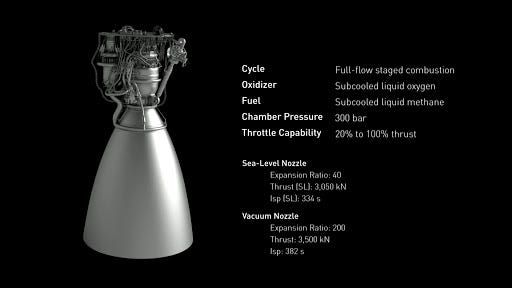
Elon Musk, the founder of SpaceX, said on Twitter on Wednesday that the Raptor 2 engine, which will power the Starship S20 rocket, is capable of generating approximately 5.4 tonnes of thrust during takeoff.
Simultaneously, he acknowledged that while the engine is "much improved in every manner" over the previous generation, a thorough redesign is still required to ensure that it achieves its ultimate aim of interplanetary travel.
Advertisement
SpaceX just completed the first static fire test of their Starship S20 spacecraft with all of the Raptor 2's engines activated, bringing Musk one step closer to realising his dream of building a city. Mars will be self-sufficient by 2050.
These ground-breaking engines, which run on'methalox' (a mixture of densified liquid methane and liquid oxygen), are expected to enable the business to transport goods weighing more than 100 tonnes and a hundred tonnes into orbit, as well as to the Moon and Mars.
Is SpaceX's Raptor rocket engine the most powerful in the world?
Advertisement
SpaceX's new Raptor engine is a methane-fueled full-flow staged combustion cycle engine that has been so difficult to design that no engine of this type has ever flown!
To put the Raptor engine into context, we're going to review many typical types of rocket engine cycles and then compare it to several other popular rocket engines, including SpaceX's current workhorse, the Merlin, the Space Shuttle's RS-25, the RD-180, Blue Origin's BE-4, and the F-1 engine.
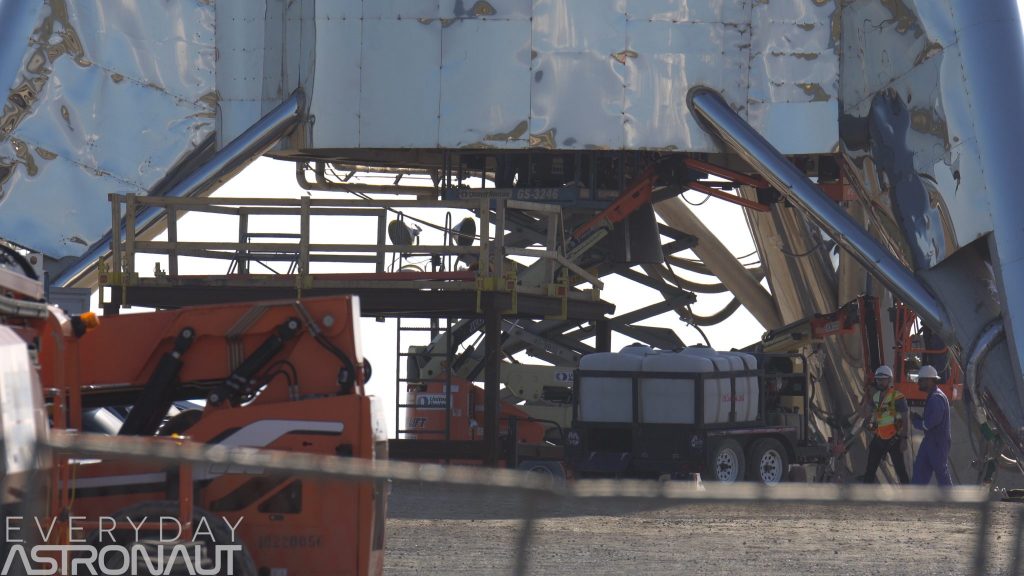
Advertisement
And if that wasn't enough, SpaceX will also be using a novel engine cycle and Liquid Methane as fuel, which no orbital rocket has ever used! As such, we'll discuss the unique properties of liquid methane as a rocket fuel and attempt to deduce why SpaceX chose methane for the Raptor engine.
Additionally, we'll breakdown and explain the various engine cycle types so you understand what the full flow staged combustion cycle is, how it operates, and how it relates to the other cycles.
By the end of this article, we should have enough context to understand why the Raptor engine is unique, how it compares to other rocket engines, why it is powered by methane, and whether the Raptor engine will become the new king of rocket engines...
In case you weren't aware when you clicked on this page, it is an EXTREMELY LONG article... I'm not sorry. However, if you're anything like me, you're constantly hearing about the Raptor engine and want to appreciate it... but you're at a loss about where to begin.
To be honest, I've spent quite some time researching this subject thoroughly in order to establish a solid foundation for truly appreciating the Raptor engine, and quite simply, all rocket engines!
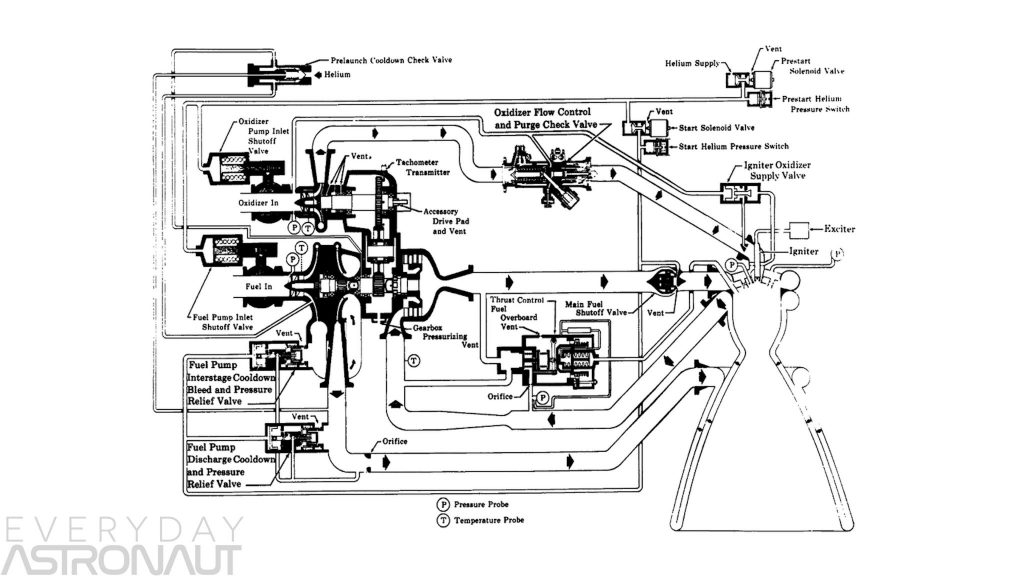
Advertisement
And, if you're anything like me, you've probably spent hours staring at diagrams like these and had your head burst every time. To avoid this, I've created some extremely simplified versions of the rocket engine cycles for all of us to enjoy, in the hopes that they'll help us grasp these concepts.
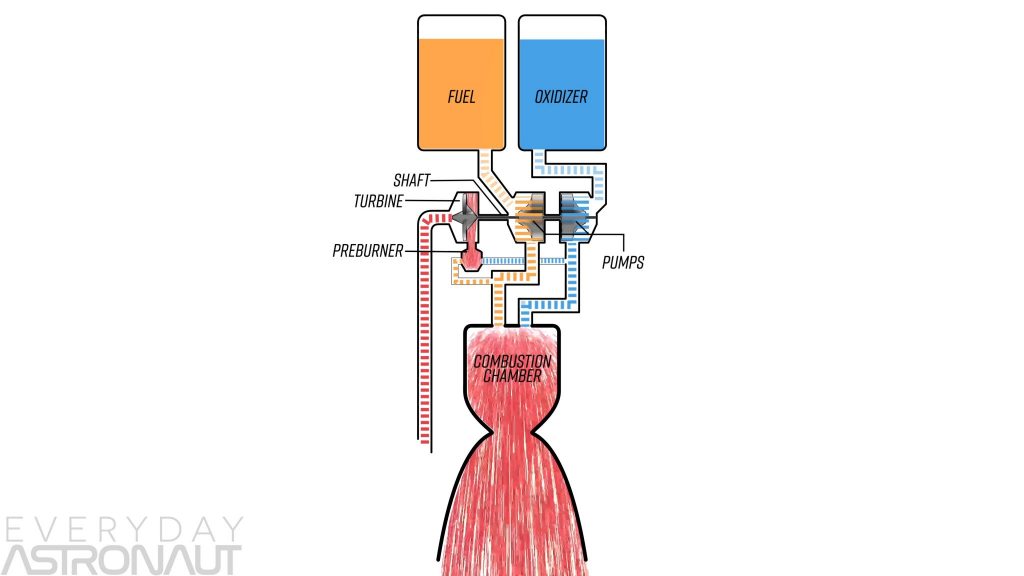
Advertisement
Now, we're going to begin with a little physics lesson, but stick with me; we're going to dig right in and get into the nitty gritty details... We'll leave no stone unturned, and by the end of this post, you should have a firm understanding on how rocket engines function, the various liquid-fueled rocket engine variants, why methane is a viable fuel source, and how the Raptor engine compares to some other popular rocket engines.
Rockets are essentially just propellant wrapped in a skin to keep it in place, with a device on the back capable of hurling this propellant extremely quickly. Additionally, the faster you can toss that propellant, the better.

Advertisement
The simplest way to accomplish this is to store all of the propellant in your tanks at extremely high pressure, then attach a valve to one end of the tank and a propelling nozzle to convert the propellant to usable thrust.
DONE! There are no insane pumps or sophisticated systems; simply open a valve and let the beast loose.
This is referred to as a pressure fed rocket engine, and there are several different types: cold gas, monopropellant, and bipropellant pressure fed rocket engines. These are frequently employed in response control systems due to their simplicity, reliability, and speed.

Advertisement
However, pressure fed engines have a significant limiting element. Because pressure continuously flows from high to low, the engine's pressure can never exceed that of the propellant tanks.
To hold propellant under high pressure, your tanks must be robust, which means they must be thicker and heavier. Consider composite overwrapped pressure vessels, commonly abbreviated as COPVs. They are capable of storing gases at pressures of about 10,000 psi, or around 700 bar.

Advertisement
Despite this, they can only hold a finite quantity of propellant and pressure. This approach does not scale well when attempting to deliver a cargo to orbit.
Thus, astute rocket scientists rapidly recognised that there is really just ONE thing they could do to make the rocket as light as possible. Boost the enthalpy. That would be an excellent name for a 90's metal band. You are more than welcome, internet.

Advertisement
Enthalpy is a mathematical expression that describes the relationship between volume, pressure, and temperature. Increased pressure and temperature inside the combustion chamber translate into increased efficiency, and more mass pushed through the rocket engine translates into increased thrust.
Therefore, to increase the amount of propellant in the engine, you can either increase the pressure in the tanks or directly inject the propellant into the combustion chamber using a high-powered PUMP. The second option, though, does sound like a decent idea!
However, PUMPS that move hundreds of litres of gasoline per second require a great deal, and I mean a great deal, of energy to operate. What if you took a miniature rocket engine and directed it directly towards a turbine, rapidly spinning it up?
You could convert some of the chemical energy in the rocket propellant to kinetic energy, which could then be used to spin these enormous pumps.

Advertisement
Welcome to the staged combustion cycle and turbopumps! But there are still some limitations, such as how high pressure always wants to go to low pressure and how heat has a tendency to melt things... So, while attempting to extract every ounce of power from your engine, you must keep all of these factors in mind.
Now, there are a lot of cycles we could discuss here, but I'm going to stick with the three most common, or at least the three that matter the most when considering the Raptor.
We'll look at the gas generator cycle, partial flow staged combustion cycle, and full flow staged combustion cycle... I'll try to do a full rundown of all liquid fueled rocket engines in a future article, including some fun new alternatives like the electric pump fed engines seen on Rocket Lab's Electron rocket.
Let's start with the open cycle, also known as the gas generator cycle. On orbital rockets, this is probably one of the most common types of liquid-fueled rocket engines. It's more complicated than a pressure-fed system, but it's still relatively straightforward, at least in comparison to their closed-cycle counterparts.
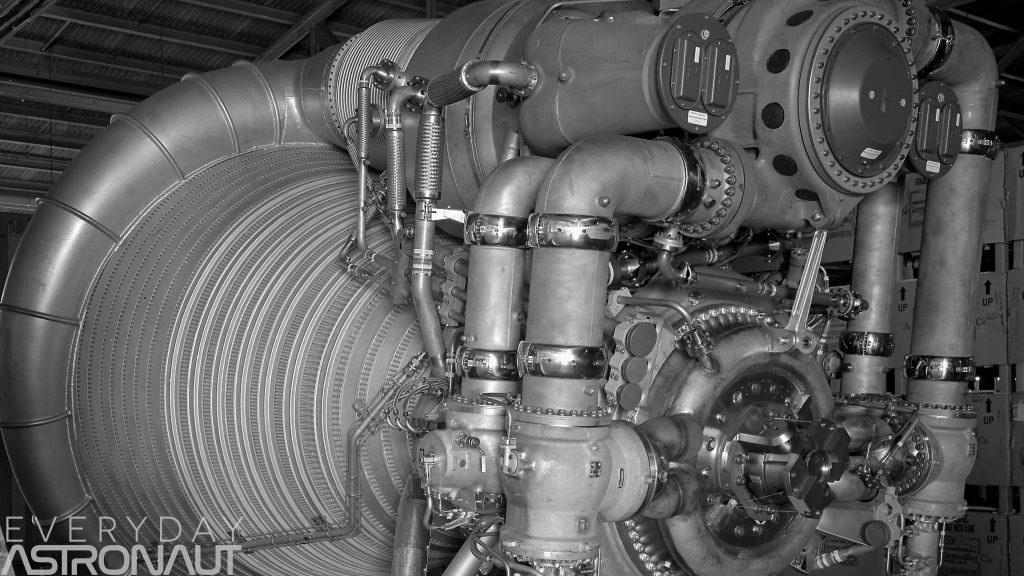
Advertisement
Pumps, valves, and pipes for the F-1 engine
Now I'm going to oversimplify this to make it as easy to understand as possible. There are dozens of valves, a hive of wires and extra small pipes in real life, helium to back pressure the tanks, fuel flowing through the nozzle and the combustion chamber to cool it, and an ignition source for the preburner and the combustion chamber....
But, again, just know that there's a lot of stuff missing for the sake of keeping things simple and digestible, so just know that there's a lot of stuff missing, but we're focusing on the flow of these engines to get that concept down.
After you've mastered these basic variants, it'll be lot simpler to look at something like this without your head exploding.
Advertisement
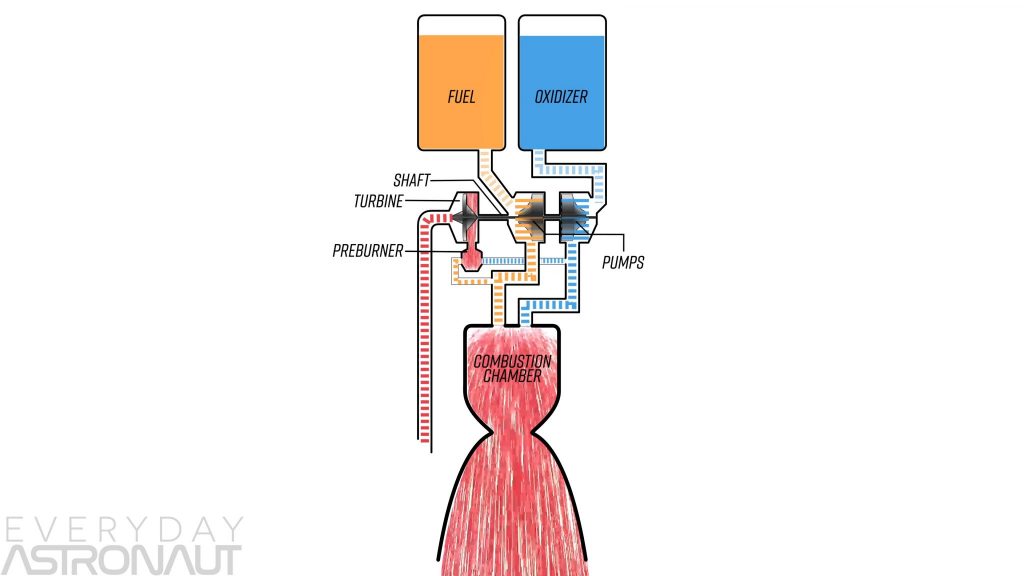
Diagram of a schematic flow for an open cycle gas generator
A turbopump pumps the fuel and oxidizer into the combustion chamber in the gas-generator cycle. The turbopump consists of a preburner, which is a miniature rocket engine, a turbine connected to a shaft, and one or more pumps that push propellant into the combustion chamber.
The turbopump unit is sometimes referred to as the powerpack because it is what drives the engine. The spent propellant from the preburner is simply dumped overboard in the open cycle system and does not contribute any significant thrust. Because the fuel and oxidizer used to spin the pumps are essentially wasted, it is less efficient.
The interesting thing about a turbopump is that it has a chicken and egg problem that makes it difficult to start up since the preburner that powers the turbopump requires high pressure fuel and oxidizer to function... So the preburners require the turbopumps to spin before they can reach full operational pressure, but the turbopumps require the preburner to fire before they can spin... However, the turbopumps, etc., are required for the preburner.
Starting a gas generator is difficult as a result of this. There are a few ways to accomplish this, but we won't go over all of them in this article; however, it sounds like a fun topic for a future article.
Returning to the turbopumps, remember that pressure always flows from high to low, so the turbopumps must operate at a higher pressure than the chamber.
This means that the inlets leading into the preburner have the highest pressure in the rocket engine, while everything downstream has a lower pressure.
Advertisement
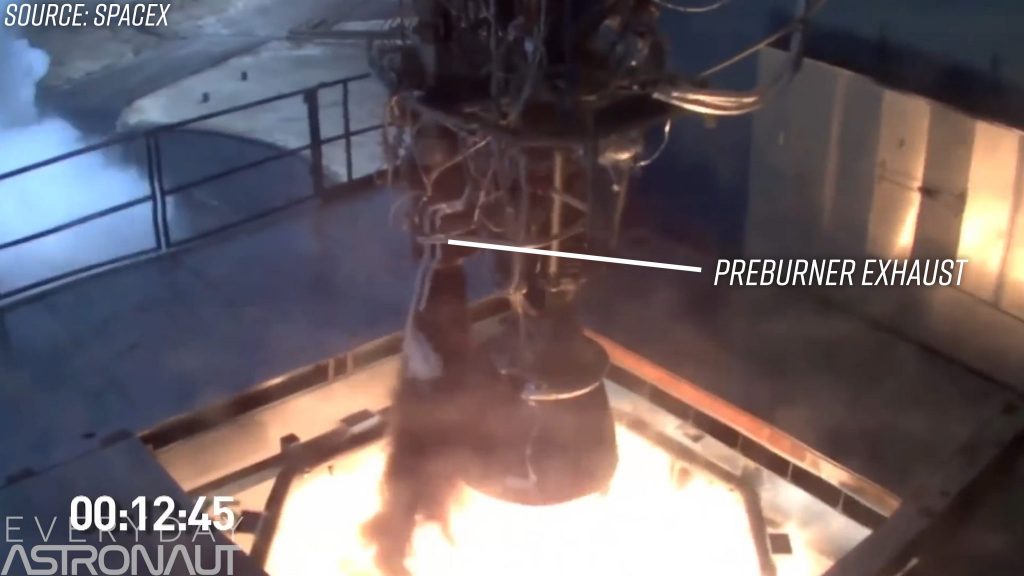
Merlin engine open cycle preburner exhaust shoot
But take note of something. Consider SpaceX's Merlin engine, which uses RP-1 (Rocket Propellant 1) and Liquid Oxygen. Notice how dark the smoke from the preburner exhaust is...
Why is it so much more sooty than the main combustion chamber, which produces almost no visible exhaust? That's because rocket propellant may reach extremely high temperatures, in the thousands of degrees Celsius range.
To ensure that the temperature does not become so high that it melts the turbine and the entire turbopump assembly, they must ensure that it is cool enough to operate continuously. The most efficient and releases the most energy when running at the perfect fuel and oxygen ratio, but it also produces a lot of heat.
You can run the preburner at a less-than-optimal ratio to keep the temperatures low, such as too much fuel (fuel rich) or too much oxidizer (oxygen rich).
If you run an RP-1 engine at a high RPM, you'll notice some unburned fuel in the form of dark clouds of soot. Coking is the process of unburned carbon molecules bonding and forming polymers under high pressure. This soot sticks to everything it comes into contact with, clogging injectors and even causing damage to the turbine itself!
Advertisement
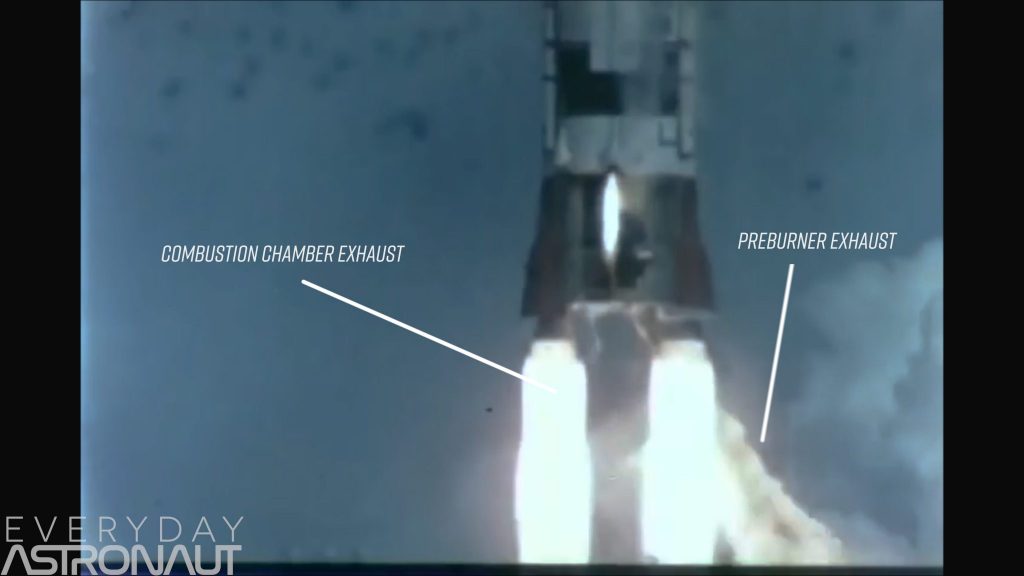
Engine open cycle with preburner exhaust smoke
What if you didn't want to throw away that highly pressurised propellant... After all, if it's running cooler because it's rich in fuel, doesn't that mean there's a lot of unburned fuel being wasted?
What if that hot exhaust gas could simply be piped into the combustion chamber?
Welcoming you to the end of the cycle!
The closed cycle or staged combustion cycle improves engine efficiency by repurposing otherwise wasted exhaust and connecting it to the combustion chamber to help raise pressure and thus efficiency.
So, let's have a look at the Merlin engine and see if we can close the loop. Let's just pipe that exhaust right into the combustion chamber! OH NO!!!! OH NOOOOOOOOOOOOO
"Today you are not going to space."
Advertisement
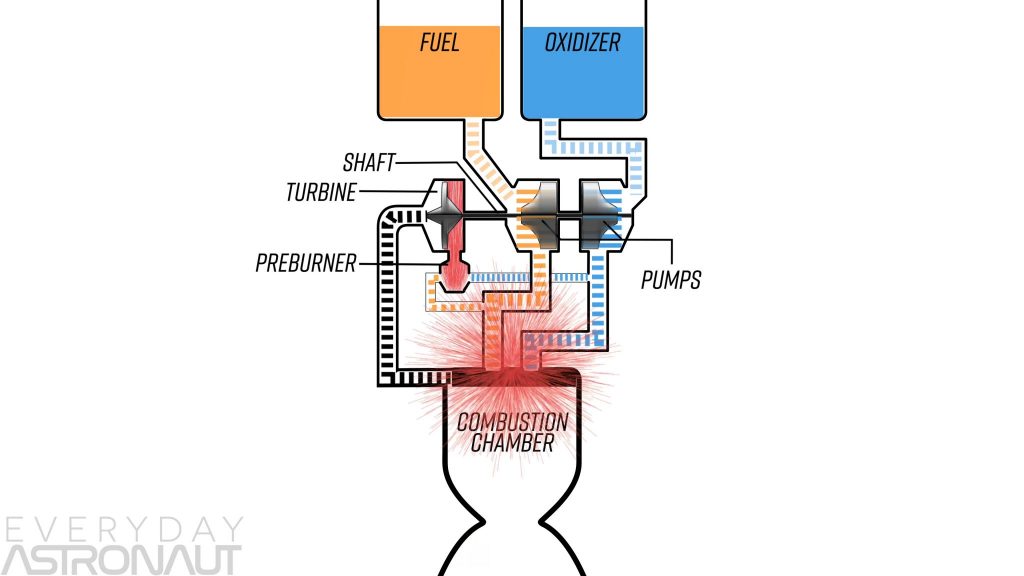
Closing the loop of a clogged injector in an open cycle
However, there are a few solutions to this problem, so let's look at how the Soviets dealt with it. The NK-15, designed for their N-1 moon rocket, was the first operational closed cycle engine they produced; it was later upgraded to the NK-33, and many versions followed, including the RD-180, which is still used on the Atlas V today.
Advertisement
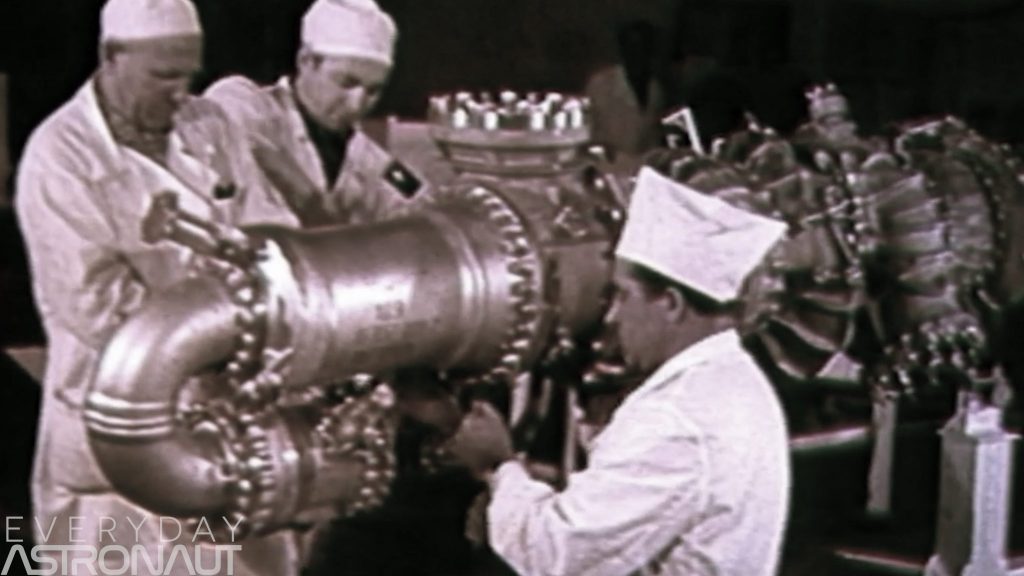
The Soviet NK15 and NK33 are being constructed.
Because the NK-15 and NK-33, like the Merlin, run on RP-1, you can't run your preburners fuel rich due to the coking issue... So, if you want to make an RP-1 closed cycle engine, the answer is to run the preburner oxygen rich. Isn't it that simple? Now you're blasting SUPER HEATED highly pressurised gaseous oxygen at a precision machined, insanely high tolerance turbine blade, which will turn anything into soup.
Advertisement
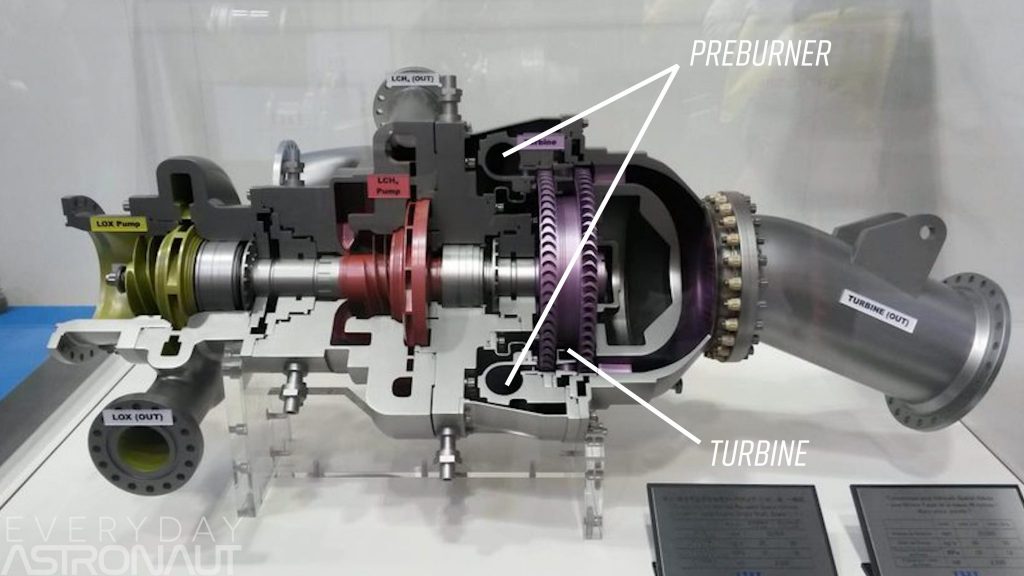
Preburner and turbine
The United States considered it impossible to accomplish this, so they gave up. They didn't believe a metal alloy could withstand these insane conditions, and they didn't believe the Soviets could build such an efficient and powerful RP-1 powered engine until after the Soviet Union fell apart and US engineers saw and tested them for themselves!
The Soviets, on the other hand, had toiled away and created a special alloy that can magically, thanks to science, withstand the wacky conditions of an oxygen-rich preburner.
You don't just burn some fuel and oxidizer in the preburner to spin the turbine in a closed cycle engine; you actually shoot ALL of the rich propellant through the turbine.
So, in an oxygen-rich cycle, all of the oxygen passes through the preburner, and the preburner receives just the right amount of fuel. You only need enough to give the turbine enough energy to spin the pumps fast enough to get the right pressures for the preburner and combustion chamber to produce enough power to launch something into space AH
Advertisement
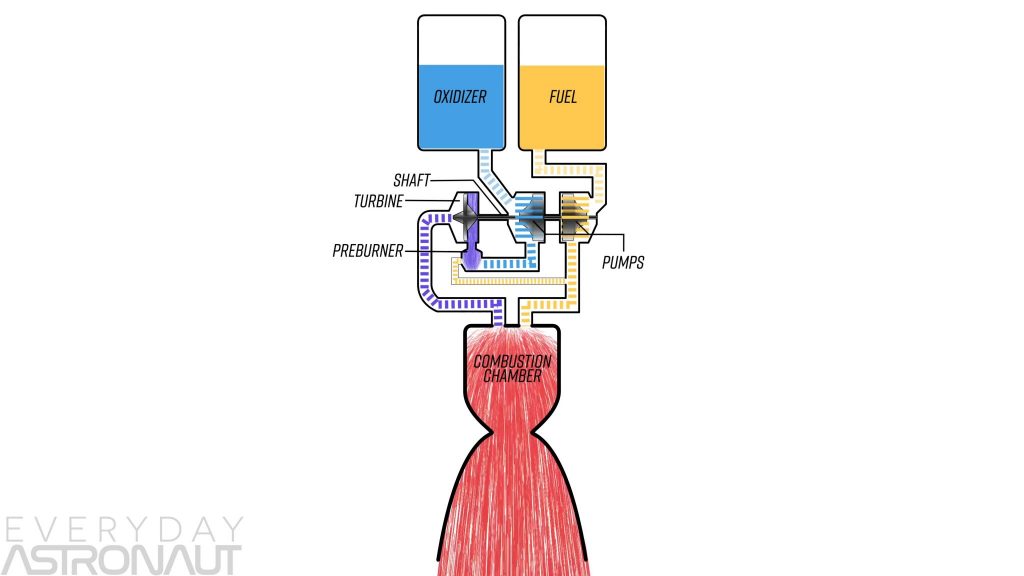
NK33 RD180 is an oxygen oxidizer with a closed cycle.
Sorry, but returning to the oxygen-rich preburner, hot gas oxygen is now driven into the combustion chamber, where it collides with liquid fuel. They collide and go boom, giving us a very clean and efficient burn while wasting very little propellant! HUZZAH!
BUT, like with other engines, the chamber pressure cannot exceed the pump pressure, putting a lot of strain on the pumps' metal tiny shoulders.
Now, if you're thinking that the US should have just sat back and let the Soviets have all the closed-cycle glory, you're mistaken. The United States took a little longer to figure out a closed cycle engine, but it was quite different from the oxygen-rich cycle...
The United States opted for a closed loop cycle with a fuel-rich preburner. But hold on.... We just learned that the exhaust from a fuel-rich preburner is sooty that it will ruin just about anything... right?
Sure, if you're using RP-1 or any other carbon-based fuel, that'll be the result... As a result, the United States chose a new fuel: hydrogen! Okay, so we've dodged the problem of blasting insanely hot high-pressure oxygen at everything valuable, but we've also opened up a new can of worms... Hydrogen has a lower density than RP-1 or liquid oxygen.
In fact, it's so much less dense that getting the correct amount of hydrogen into the combustion chamber requires a massive turbopump.
Because RP-1 and LOX have identical density and ratios, they can be run on the same shaft with the same preburner.... Because Hydrogen is less dense and requires a greater fuel ratio, the pumps for Hydrogen and LOX are vastly different.
Advertisement

Preburner for SSME Rs25 powerpack powerhead turbopump hydrogen pump
As a result, Rocketdyne engineers developed the RS-25 engine, which would eventually power the space shuttle. They discovered that because the pumps are so dissimilar, they could merely have two preburners, one for the hydrogen pump and one for the oxygen pump. That's exactly what they did!
Advertisement

ssme rs25 hydrogen seals purge seals leaky hydrogen preburners
However, having two distinct shafts caused yet another issue. Engineers were now putting high-pressure hot gaseous hydrogen on the same shaft as the liquid oxygen pump, directly next to it.
If some hydrogen escapes from the preburner, it could cause a fire in the lox pump, which would be disastrous. Hydrogen is similarly difficult to hold due to its lack of density, or lack of density? Lightweight?
It prefers to slip between crevices and escape anywhere it can. As a result, engineers had to devise a complex seal to prevent the hot hydrogen from escaping.
Advertisement
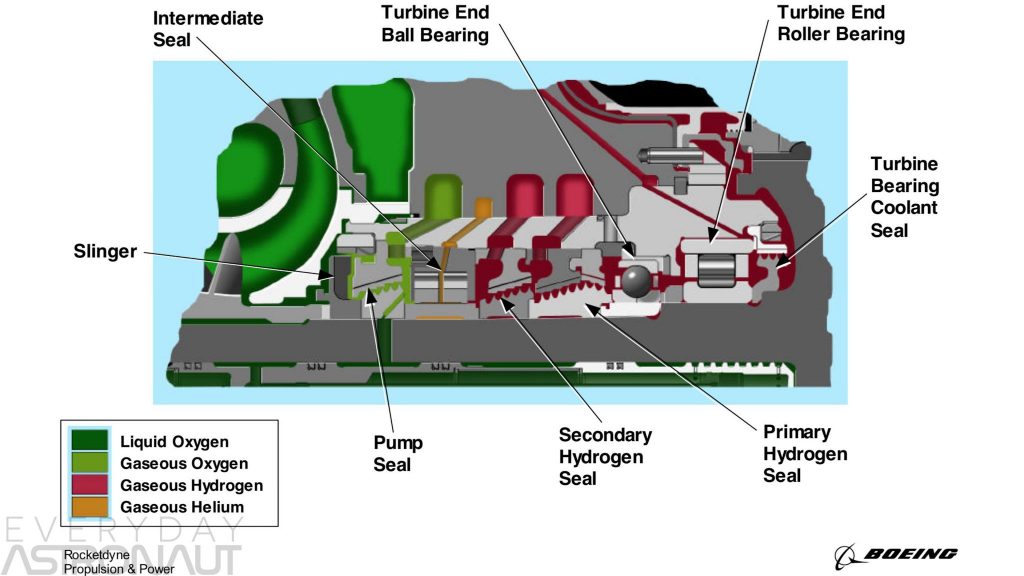
ssme rs-25 purge seal
The seal necessary for this is known as a purge seal, and it is really pressured by helium, making it the highest point of pressure. If the seal leaks, it just leaks inert helium! Genius.
Take a look at how the seals on the LOX turbopump and the hydrogen turbopump are different. You can see that the lox seals took a lot more engineering time and effort. THE PEOPLE WHO THINK LIKE THIS ARE CRAZY!!!!!
Now that we've covered everything there is to know about the dual burner, fuel-rich RS-25, here's a simplified diagram of it. I didn't bother making the gasoline pumps different sizes because I wanted to concentrate on the flow and make it as simple as possible.
Advertisement
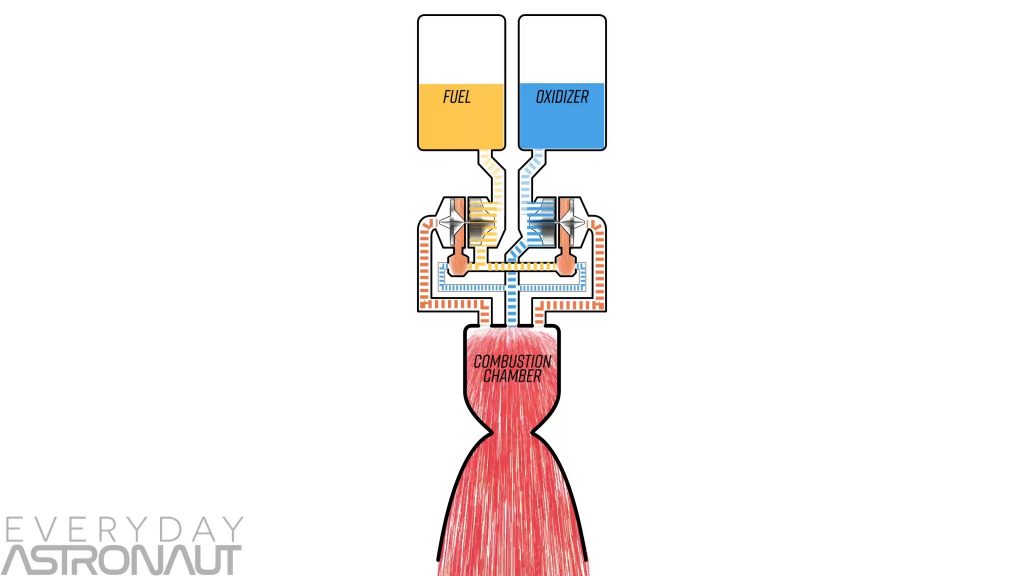
rs-25 schematic ssme fuel rich closed cycle
But keep in mind that the RS-25's two preburners run on the same amount of fuel, they just use separate pumps. With a relatively high thrust to weight ratio and unparalleled efficiency, the RS-25 is still considered to be about the greatest engine ever constructed.
But the closed cycle enhances the engine's overall performance and is quite beneficial, so how could it get much better?
Finally, we may discuss the full flow staged combustion cycle, which essentially combines the two closed cycle processes we just discussed. You use two preburners in the full flow staged combustion cycle, one that burns fuel and the other that burns oxygen.
The fuel pump is powered by the fuel rich preburner, whereas the LOX is powered by the oxygen rich preburner. This means that the entire flow cycle must address the oxidizer-rich issues, which can be solved once again by manufacturing extremely strong metal alloys.
Advertisement
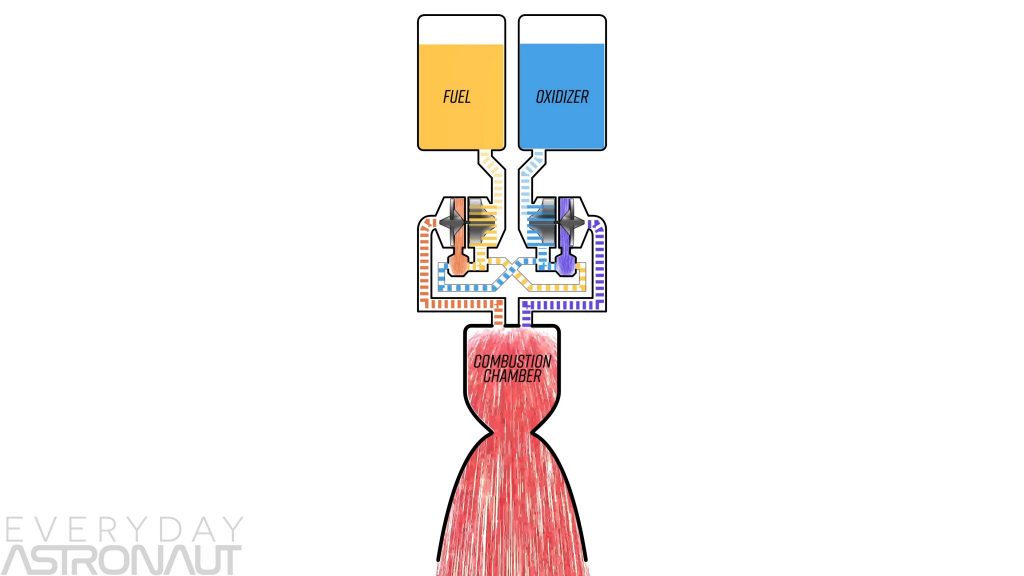
Schematic of a full-flow staged combustion cycle
As a result, SpaceX created their own superalloy, which they dubbed SX500. It can produce over 800 bar of hot oxygen-rich gas, according to Elon. One of the most difficult challenges in building the Raptor engine may have been this.
Advertisement
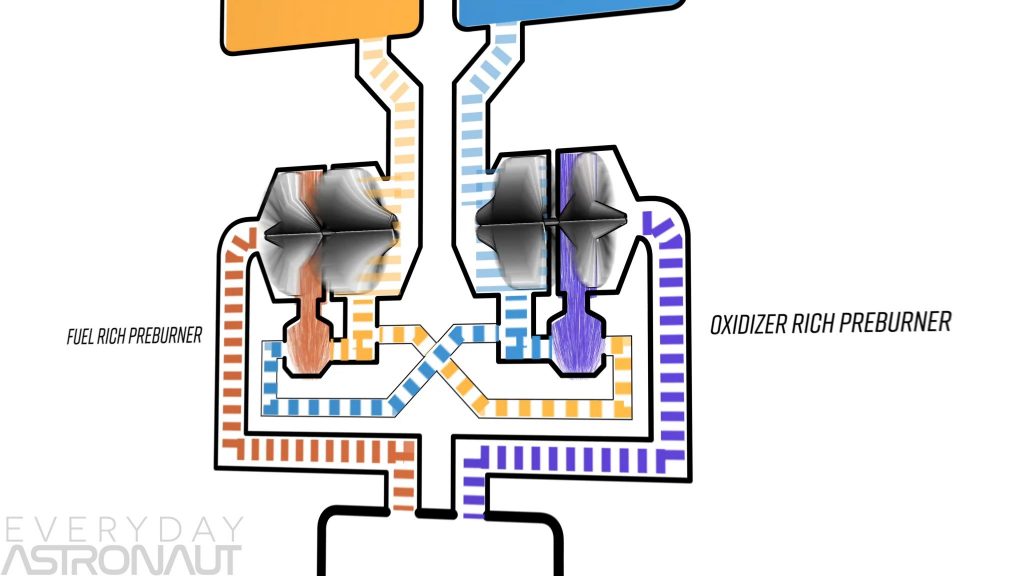
Schematic of a full-flow staged combustion cycle
Fortunately, the fuel rich side merely pumps gasoline, so if some hot fuel seeps through the shaft seal, it simply contacts more fuel, which isn't a major concern. Due to the coking issues with a fuel-rich preburner, full flow is unlikely to operate with RP-1, but other fuels are still viable for use with this design; more on that in a minute...
This technology has the benefit of greater combustion and higher temperatures since both the fuel and the oxidizer arrive in the combustion chamber as a hot gas.
There is also less of a requirement for that bizarre sealing mechanism we mentioned previously, resulting in less renovation. When you plan to reuse your engine multiple times with little to no maintenance in between flights, this is a positive thing.
Finally, because the ratio of fuel and oxidizer required to spin the turbopumps is significantly lower, the turbines can run cooler and at lower pressures due to the natural increase in mass flow, or how quickly all the propellant is shooting into the preburner.
Consider it this way: in an open cycle, you only want to waste as little fuel and oxidizer as possible in the preburners, and you want it to be as hot as possible to increase efficiency.
Advertisement
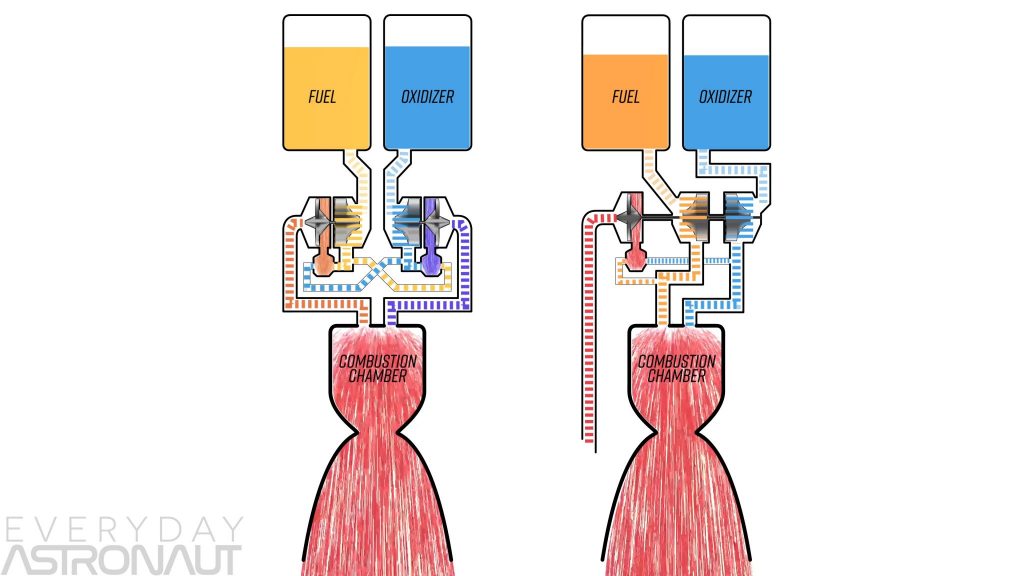
Diagram of a full-flow staged combustion cycle vs. an open cycle
Because all of the fuel and oxidizer passes through the preburners in a full flow cycle, you can burn as much propellant as you need to power the turbopumps....
BUT, your fuel to oxidizer ratio will be so crazy fuel and oxygen rich that the temperatures at the turbines will be much lower, resulting in longer turbopump assembly lifespans. It also implies that more combustion takes place in the combustion chamber rather than the preburner.
Here's where things get a little wacky. Only three engines have ever demonstrated a complete flow-staged combustion cycle.
Advertisement

Engine RD 270
The Soviets created the RD-270 engine in the 1960s, but it never flew, and Aerojet and Rocketdyne worked on an integrated powerhead demonstrator named, wait for it, the integrated powerhead demonstrator in the early 2000s, but it never flew.
Advertisement

Demonstrator of an integrated powerhead
SpaceX's Raptor engine is the third attempt at constructing a full flow staged combustion cycle engine!!!! FINISHED!!! WE SUCCESSED!!!
That's true, the Raptor engine is only the THIRD attempt at creating such a beast. It's the first time it's ever done any job and then walked away from the test stand! With luck, it will also be the first full flow staged combustion cycle engine to reach orbit.
Actually, nearly everything this engine accomplishes will be a first.
But all of this means SpaceX had to deal with a slew of challenging issues. Not only did they have to overcome the same issues with an oxygen-rich cycle, but they also had to precisely regulate fuel to achieve the highest chamber pressure of any rocket engine ever, at 270 bar, finally surpassing the RD-180's record of roughly 265 bar.
They're not done yet; they're aiming for 300 bar, which is insane; more on that in a moment.
Advertisement
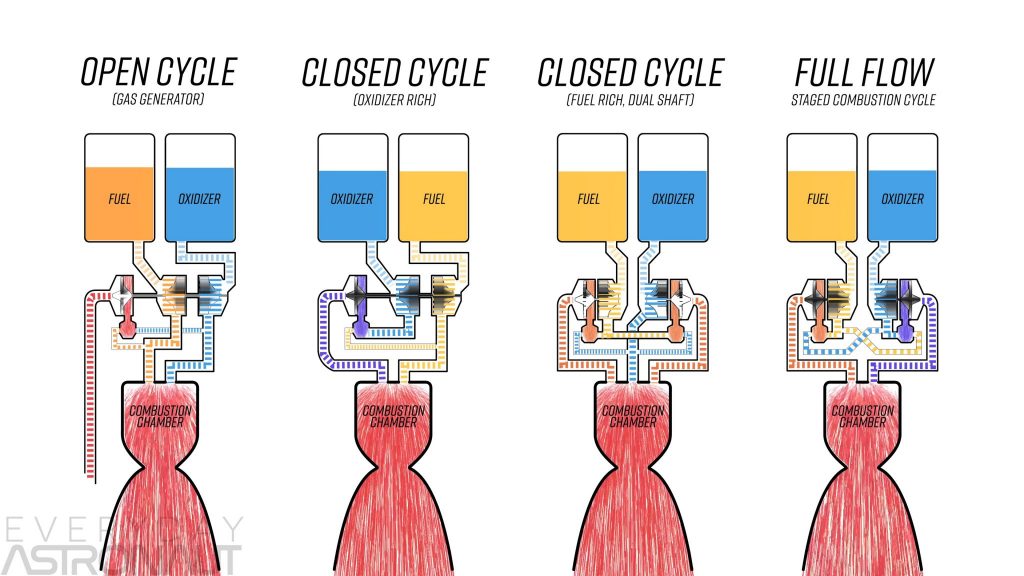
Open cycle closed cycle fuel rich oxygen rich complete flow staged combustion cycle diagram schematic flow for all rocket engine cycles
Because the Raptor can't run a fuel-rich preburner on RP-1, you'd imagine Hydrogen would be the next best thing... SpaceX, on the other hand, chose Liquid Methane over RP-1 or Hydrogen! So now we have another item to discuss...
Why did SpaceX opt for liquid methane as the Raptor's fuel? What are the characteristics that make it superior to hydrogen or RP-1?
Since no liquid methane or methalox engine has yet to reach orbit, what characteristics do they possess that make them desirable? Take a look at how methalox stacks up against keralox and hydrolox...
Place methane between RP-1 and Hydrogen... You'll shortly understand why...
So, let's start with the most important element to consider while constructing your initial stage. The propellant's mass density. Tanks are smaller and lighter for a given mass of fuel when the fuel is denser. A lighter rocket means a smaller tank.
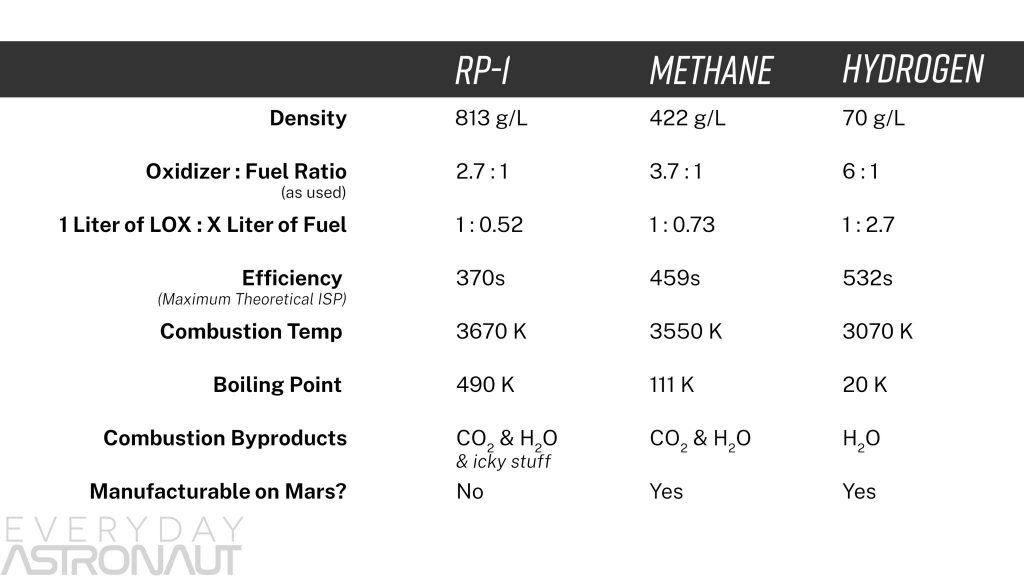
So here's the density of these three fuels in grams per litre, or how much how much does one litre of this thing weigh, or how much mass does it have?
Starting with RP-1, which weighs roughly 813 kilos per litre, RP-1 is 11 times more dense than Hydrogen, which weighs only 70 grammes per litre, and Methalox, which weighs 422 grammes per litre, is squarely in the centre.
Remember when airships and zeppelins were loaded with hydrogen to make them "lighter than air"... Hydrogen is a wonderful, albeit flammable, gas for a balloon since it is so much less dense than our atmosphere. We've all heard of the Hindenburg, right?
It's also worth noting that the usual density of RP-1 is 813 grammes per litre, but SpaceX chills their RP-1 in their Falcon 9 and Falcon Heavy for a 2 percent to 4 percent boost in density. However, the density of RP-1 has always been roughly 813 grammes per litre.
So, in terms of density, Methane falls somewhat in the middle of the pack. But density isn't the only factor to consider; we also need to examine the ratio of fuel burned to oxidizer burned. This is the ratio of oxidizer to fuel.
This is where things start to become a little more interesting, and the tables begin to turn. Engineers must account for the mass of the fuel and the weight of the tanks, thus instead of burning propellant at the ideal stoichiometric combustion ratio, they seek out the ideal happy medium that balances tank size with thrust production and specific impulse.
Let's take a look at the fuel-to-oxidizer mass ratios that the engineers have devised... For these calculations, RP-1 burns at 2.7 grammes of oxygen per gramme of RP-1, Hydrogen at 6 grammes of oxygen per gramme of hydrogen, and Methane at 3.7 grammes of oxygen per gramme of Methane. These figures can now help to balance out the large density disparity.
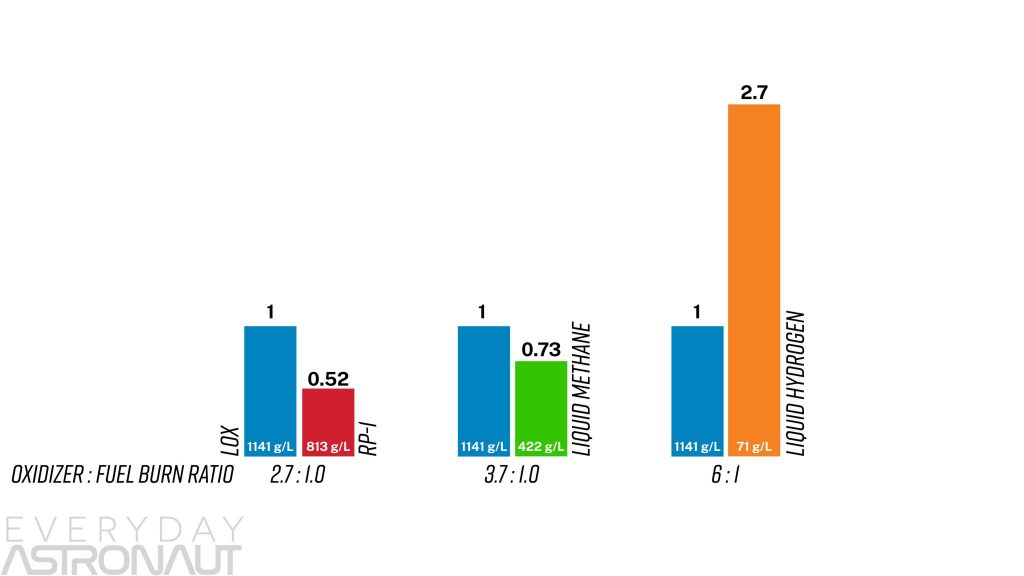
Advertisement
Hydrolox hydrogen fuel tank size vs. methane methalox vs. rp1 keralox vs. LOX liquid oxygen density Hydrolox hydrogen fuel tank size vs. methane methalox vs. rp1 keralox vs. LOX liquid oxygen density
So, to make it easier to understand, let's picture it. Liquid oxygen has a density of 1,141 grammes per litre, which is somewhat higher than RP-1. So, if you burn LOX and RP-1 at a 2.7 to 1 ratio, you'll require a little more than half a litre of RP-1 for every litre of LOX.
Let's move on to Hydrogen. Given that Hydrogen is 11 times less dense than RP-1, you'd assume it'd require an 11-fold larger tank... However, engineers have discovered that burning LOX and Hydrogen at a 6:1 ratio is a good compromise.
This means you'd need 2.7 litres of hydrogen for every litre of LOX! As a result, your fuel tank must be approximately 5 times larger than the RP-1... So, yeah...
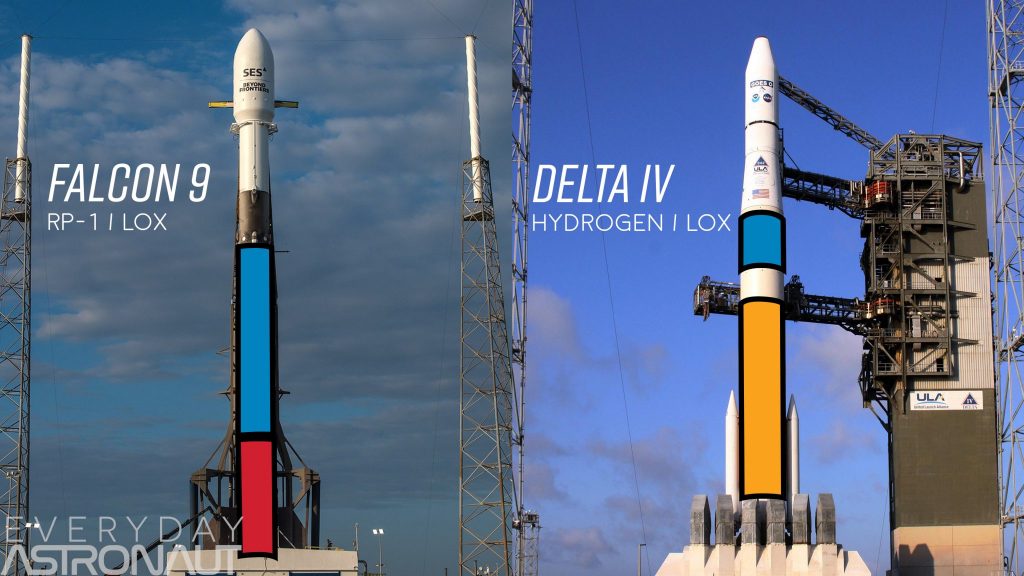
Size density of Falcon 9 RP-1 tank and oxygen tank against delta iv hydrogen tank and lox tank
That's why, when comparing a Hydrogen-powered Delta IV to an RP-1-powered Falcon 9, the fuel tank on the Falcon 9 is significantly smaller than the LOX tank on the Delta IV, but the converse is true! The LOX tank is a fraction of the size of the fuel tank.
Let's take a peek at that methane now. This is a fascinating one. Although LOX is 2.7 times denser than liquid methane, it burns at a ratio of 3.7 grammes oxygen to 1 gramme methane. As a result, you'll require.
For every litre of LOX, 73 litres of methane are produced. To put it another way, your fuel tank would need to be around 40% larger for methalox than it would for RP-1, despite the fact that RP-1 is almost twice as dense! Its fuel tank would be 3.7 times smaller than that of Hydrogen.
As a result of the fuel to oxidizer ratio, Methalox's fuel tanks are much closer to RP-1 than Hydrolox's.
Another important factor to consider with any rocket engine is its efficiency. This is measured in specific impulse, or ISP, and can be compared to the fuel economy of a gasoline-powered vehicle.
As a result, a high specific impulse is comparable to a high mpg or kmpl. Consider the following scenario: you have one kilogramme of propellant; how many seconds can the engine push with 9.81 newtons of force?
The higher its specific impulse, and thus the more work it can do with the same amount of fuel, the longer it can sip on the fuel while still pushing that hard. It is, in other words, a matter of fuel economy.
As a result, the higher the particular impulse, the less fuel is required to perform the same amount of work, which is beneficial. It is critical to have a fuel-efficient engine! And now, depending on the molecular weight of each fuel and the energy released when it is burned, the exhaust gas can be expelled out the nozzle at a different rate. This means that each fuel has a different specific impulse in theory.
In an ideal world, an RP-1-powered engine would clock in at around 370 seconds, a hydrogen-powered engine would clock in at 532 seconds, and a methane-powered engine would clock in at 459 seconds. However, real-world instances are substantially shorter, with RP-1 engines clocking in at roughly 350 seconds (Merlin 1D Vacuum), 380 seconds for a methane engine (raptor vacuum), and 465 seconds for a hydrogen engine (RL-10B-2)
Let's move on to the temperature at which each fuel burns. Cooler-burning fuel is kinder on the engine and may result in a longer lifespan. RP1 can burn at 3670 kelvin, Hydrogen at 3,070 kelvin, and, if you haven't guessed, Methane at 3550 kelvin.
Let's look at the boiling point of these fuels, or the point at which the liquid fuel boils off and turns into a gas, while we're on the subject of thermal concerns. Because all of these fuels must remain liquid in order to maintain their density, the greater the temperature, the easier it is to store them.
A greater boiling point also indicates that the tanks will have little or no insulation to keep the propellant from boiling away. Less insulation also translates to lighter tanks. YAY.
RP-1 has a very high boiling point of 490 kelvin, which is even higher than water. Hydrogen, on the other hand, has a temperature of 20 kelvin, which is near absolute zero! That is extremely cold, and keeping anything at that temperature necessitates careful consideration. And it's just like Goldilocks...
Methane is halfway between the two, with a temperature of 111 kelvin, which, while still chilly and requiring thermal considerations, boils off at a temperature similar to LOX, so there's that!
Because the temperature is so near to that of LOX, the tanks can use a common dome, making the vehicle lighter. The temperatures of LOX and hydrogen differ so greatly that LOX will boil off hydrogen and the hydrogen will solidify the LOX!
Now let's talk about exhaust. What are the combustion byproducts in these engines? RP-1 is the only one of these three that pollutes the atmosphere by leaving unburned carbon in addition to water vapour, whereas hydrogen only creates water vapour, while methane produces both carbon dioxide and water vapour.
However, it's worth noting that, believe it or not, water in the high atmosphere can be quite harmful in terms of greenhouse gases... But, in the future, I'll write an article regarding how much rockets pollute, taking into account not only air pollution, but also ocean pollution and even space debris. So keep an eye out for that one, because I think it'll be really interesting!
The cost connected with each fuel is one measure we'll discuss, but just in general. These tend to vary a lot, and it's actually rather difficult to pin down specific rates. However, for purposes of comparison, RP-1 is essentially a highly refined jet fuel, which is a highly refined kerosene, which is a highly refined diesel. As a result, it's safe to presume it'll be more expensive than diesel.
Despite its abundance, hydrogen is somewhat expensive due to the cost of refining, storing, and transporting it. Methane, on the other hand, is essentially the same as natural gas and can be rather affordable.
When it comes to buying literal tonnes of fuel, the cost of fuel may rapidly add up, so while it shouldn't be a major component, it should be taken into account... But, since we don't have any hard data on this one, I'm not going to include it in our graph. Instead, let's talk about the more significant component of the fuel. Producing it...
Here's where we get into why SpaceX considers methane to be an essential, if not necessary, element of their long-term strategy.
SpaceX's ultimate goal is to construct a technology that can transport humans to Mars and back multiple times. The Martian atmosphere is rich in CO2, and when combined with water mining from the surface and subsurface water on Mars by electrolysis and the Sabatier process, the atmosphere can be converted to methane fuel! As a result, you won't need to bring all of the fuel you'll need to get home with you. You can make it right there using Mars’ resources.
ISRU stands for in-situ resource use. You might be thinking, "Well, if there's water on Mars, can't you just generate Hydrogen for your fuel?" Yes, but the boiling point of Hydrogen is one of the most serious issues with Hydrogen and long-duration missions. Maintaining Hydrogen at the liquid state required for use as a fuel necessitates careful thought.
So methane makes a lot of sense for SpaceX! It's relatively dense, which means the rocket's size remains reasonable; it's fairly efficient; it burns cleanly and thus makes for a highly reusable engine; it burns relatively cool, which helps extend the engine's lifespan, which is good for reusability; it's cheap and easy to produce; and it can be easily produced on Mars!
Yes, yes, yes, yes, yes, yes, yes, yes, yes, yes We've gotten this far! Now that we have a strong grasp of how different engines operate and the fuels they might use, we can finally line them all up side by side and compare their metrics to help appreciate where each engine sits..
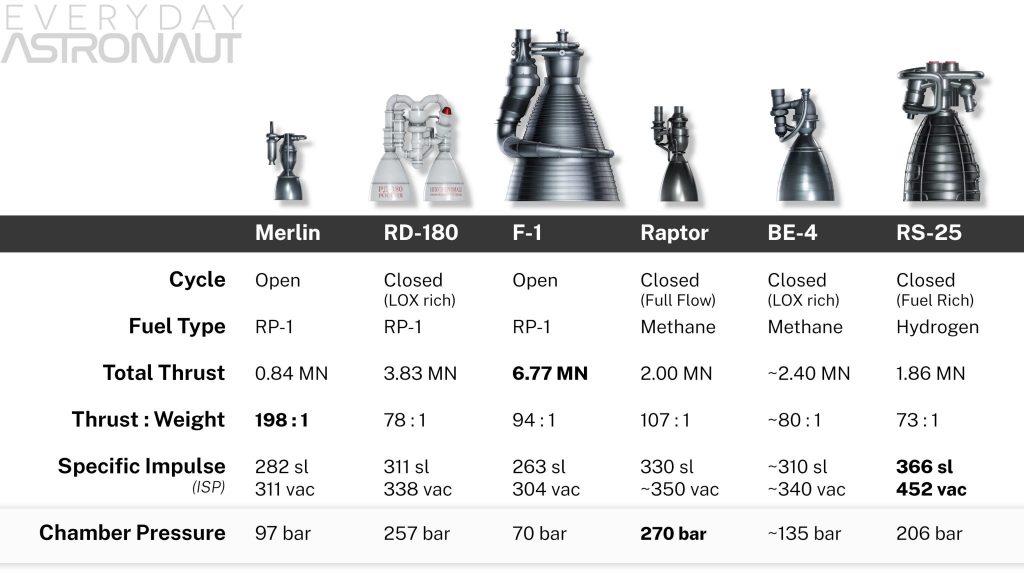
Advertisement
So now we'll arrange the engines according to their fuel types and cycles. Let's compare the open cycle Merlin engine that powers SpaceX's Falcon 9 and Falcon Heavy rockets, NPO Energomesh's oxygen-rich closed cycle RD-180 engine that powers the Atlas V rocket, and Rocketdyne's open cycle F-1 engine that powered the Saturn V, all of which run on RP-1.
Then there's SpaceX's full flow staged combustion cycle Raptor engine, Blue Origin's closed cycle oxygen rich methane powered BE-4 engine, Aerojet Rocketdyne's closed cycle fuel rich RS-25 engine, which powered the space shuttle and will power the upcoming SLS rocket that runs on hydrogen, and Aerojet Rocketdyne's closed cycle fuel rich RS-25 engine, which powered the space shuttle and will power the upcoming SLS rocket that runs on hydrogen.
Here are a few quick thoughts. The Raptor and BE-4 are still in development as of the writing of this article, therefore the numbers we have are either in their present level of advancement, like the Raptor, which is continually developing, or they are the engine's target targets, which Blue Origin has yet to achieve. So keep in mind that these figures are subject to change.
Another amusing note... Take a peek at the RD-180... Don't get me wrong: this is a single engine with two combustion chambers. There is only one turbo pump, and its power is split between two combustion chambers. The Soviet Union solved the crazy hot oxygen-rich closed cycle problem, but they couldn't solve combustion instability in large engines, so they made multiple small combustion chambers instead of one large one!
So, first and foremost, let's look at their overall thrust output at sea level, because since all of these engines operate at sea level, this is a reasonable comparison point. For fun, let's go from the least amount of thrust to the most. The Merlin generates. The RS-25 produces 1.86 MNs of thrust, the Raptor is currently at 2 MNs, the BE-4 is aiming for 2.4 MNs, the RD-180 / 3.83 MNs, and the F-1 is still the king of these at 6.77 MNs.
.
Although the RD-170 produced greater thrust than the F-1, I figured it wasn't as relevant in this lineup because it was rarely flown. I figured it's better to go with engines that have been utilised a lot!
Thrust is crucial, but the thrust to weight ratio, or how heavy the engine is relative to how much thrust it produces, is maybe just as critical when constructing a rocket. A higher thrust-to-weight ratio engine equals less dead weight for the rocket to carry.
Let's start at the bottom and work our way up. The lowest is the Space Shuttle's RS-25 at 73:1, followed by the RD-180 at 78:1, the BE-4 at around 80:1, the F-1 at 94:1, the Raptor at 107:1 (for now), and finally the Merlin at 198:1. That thing is a force to be reckoned with.
It's all well and good to have thrust, but who cares how powerful an engine is if it's inefficient? Let's look at their precise impulses, which are timed in seconds, next. We'll illustrate both the particular impulse at sea level and the specific impulse in a vacuum for this.
Starting with the least efficient engine, the F-1 at 263 to 304 seconds, we move on to the Merlin at 282 to 311 seconds, the RD-180 at 311 to 338 seconds, the BE-4 at AROUND 310 to 340 seconds, the Raptor engine at 330 to around 350 seconds, and finally the RS-25 at 366 to 452 seconds! WOAH.
Chamber pressure is now one of the elements that influences both thrust and specific impulse. The higher the chamber pressure, the more thrust and possibly efficiency the engine can produce. Higher chamber pressures allow an engine to be smaller for a given thrust level, resulting in a better thrust-to-weight ratio.
The infant here is the F-1, which had a chamber pressure of only 70 bar. I'd like to take a moment to remind you that 70 bar is 70 TIMES the atmospheric pressure... about the same amount of pressure you'd feel at 700 metres below sea level... ouch... ok, so even the lowest chamber pressure is insanely high.
So next up is the Merlin engine at 97 bar, followed by the BE-4 at roughly 135 bar, the RS-25 at 206 bar, the RD-180 at 257 bar, and finally the Raptor, which is the new king of chamber pressure at a whopping 270 bar (and they hope to bring it up to 300 bar!!!). It's like being 3 kilometres deep in the water at 300 bar. I'm at a loss for words.
Now that we've covered the technical specifications of these engines, let's move on to the operating aspects. Let's start with a rough estimate of their price. Again, because this is difficult to pin down, these are the best estimations I could come up with. These figures have been adjusted for inflation to bring them up to date.
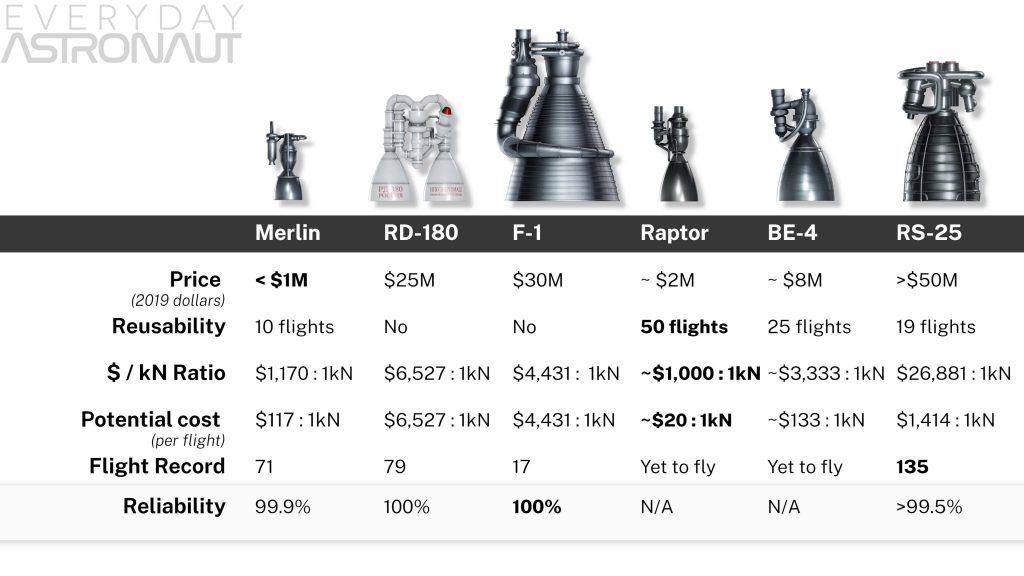
Advertisement
Be-4 vs RD-180 vs F-1 F1 aerojet SpaceX Blue Origin Merlin engine vs raptor engine vs F-1 engine against Be-4 vs RD-180 vs F-1 F1 aerojet the cost of each flight reusable reusable reusable reusable reusable reusable reusable reusable reusable flying record of dependability
Let's start with the most costly and work our way down to the least costly. The RS-25 is the most expensive engine in the lineup, with a tag price of more than $50 million per engine... ouch.
Then there's the F-1 engine, which costs $30 million per engine, the RD-180, which costs $25 million per engine, the BE-4, which costs around $8 million per engine, the Merlin engine, which costs less than $1 million, and the Raptor, which Elon believes can be produced for less than $1 million if they can remove a lot of the complexity of the current versions... So, for now, we'll say $2 million as a good ballpark figure.
Well, cost is one thing, but whether or not the engine is reusable is another important factor to consider. Only the RD-180 and the F-1 were not reusable, or were only used once... This is in contrast to all of the other engines, which will all be reused several times.
The RS-25 was reused numerous times, with the most flights coming from a single engine after only a few months of repair... The Merlin is hoping to fly up to ten times before requiring substantial repairs.
We know that the BE-4's design goal is to be reused up to 25 times, and I believe the Raptor hopes to fly up to 50 times, but goals are one thing; we'll have to wait and see how history regards these claims.
When it comes to price, there are a few aspects that become really fascinating once we start looking at the figures. The first is a number. In February of 2019, Elon noted one fascinating measure in a tweet, stating that they intend to improve the Raptor's thrust to $ ratio.
When you think about it, this is a really interesting thought. What does it matter how much an engine costs if one large engine costs less than two smaller engines for the same thrust, or vice versa? So, let's look at the $/kN ratio of these engines.
Starting with the most costly $ to kN engine, the RS-25, which has a thrust ratio of $26,881: 1 kN, followed by the RD-180 at $6,527: 1 kN, the F-1 at $4,431: 1 kN, the BE-4 at $3,333: 1 kN, the Merlin at $1,170, and the Raptor at roughly $1,000: kN.
BUT, now that we know their $/kN ratio and their reusability potential, we can take it a step further... We can now estimate their potential cost per kN per flight, which varies depending on the reusability of the engines.
For starters, because the RD-180 and F-1 aren't reusable, their prices remain the same, but when we consider how many flights each engine has/will have, the RS-25's reusability begins to pay off and close the gap, bringing its potential cost down to just $1,414: kN, but this is where things get crazy. At roughly $133 per kN over 25 flights, Blue Origin's BE-4 has the potential to be genuinely game-changing, making it about as affordable to run as the Merlin at $117 per kN per flight. However, if the Raptor engine lives up to its billing, that figure might fall as low as $20 per kN every trip. That's completely game-changing.
Sure, money and reusability are important factors in spaceflight in the twenty-first century, but what happened to proven dependability? Let's start with the number of operational flights each engine has had.
The Raptor and BE-4 have yet to experience any operational flights as of this writing, while the Raptor is starting to leave the test stand and is being employed on test vehicles like the StarHopper.
However, neither engine has a real flight record as of yet. The F-1 engine was utilised on 17 flights, followed by the Merlin engine with 71 flights and the RD-180 with 79 flights, but the RS-25 was the king of these engines with 135 flights.
Finally, how about service dependability? We can obtain a reasonably decent idea of how truly reliable an engine is based on the number of flights and this number.
This figure is difficult to nail down because some engines may have shut down early, but the mission was still completed in a couple of these cases... so take it with a grain of salt once more.
The BE-4 and Raptor have yet to fly, so those figures are unavailable; then there's the Space Shuttle main engine, which is over 99.5 percent dependable, but that's difficult to define when an engine doesn't completely shut down...
The Merlin, on the other hand, is 99.9% reliable... It helps when the vehicle has ten engines on each flight and just one engine has ever failed in flight early in its career, and the mission is still a success...
As a result, it's a very dependable engine! To sum up, both the RD-180 and the F-1 are technically 100 percent dependable, but the F-1 gets the nod here because it has never been shut down in flight...
Technically, the RD-180 is just about 100 percent reliable, depending on how you measure success and reliability. It got extremely lucky once.
Due to a broken valve, it shut down 6 seconds early on an Atlas V flight in 2016, however the operation was nevertheless successful thanks to sheer pure luck, with the centaur upperstage having enough spare Delta V to complete the mission! That mission would have failed if that valve had failed even a fraction of a second earlier.
Man… When you look at all of these figures and considerations, it's easy to see how many factors go into designing a rocket. It's mind-boggling to consider how many things can be affected by changing one small variable. Any one change might have a significant impact on the overall design and deployment of the vehicle.
So, now that we know the SpaceX cycles, fuels, and aspirations, let's go over everything again to see if we can figure out why the Raptor engines exist and if it's worth all the effort.
Let's take a look at SpaceX's long-term strategy. Make a fast, totally reusable vehicle that can carry humans to the Moon and Mars as cheaply and frequently as possible. Isn't that an unusual design aim for a rocket?
The engine must operate clean and require little maintenance, with simple turbopump seals and low preburner temperatures, in order to be quickly and completely reusable. A full flow staged combustion cycle engine powered by methane sounds like a good fit....
It makes sense to use a large number of engines for reasons of reliability, redundancy, and manufacturing scale. Chamber pressure must be high in order to scale down an engine while maintaining a high output... Hmm, a methane-fueled full-flow staged combustion cycle engine seems like a nice match...
Methane makes the most sense for interplanetary travel since its boiling point allows it to be used on long-distance travels to places like Mars, where, guess what, you can create Methane... So a methane-fueled full flow staged combustion cycle engine sounds like a suitable fit for interplanetary travel...
Because methane is relatively thick, the tank size can be kept to a minimum. Again, this is beneficial for interplanetary travel since it eliminates the need to transport dead weight... Making a full flow staged combustion cycle engine powered by methane sounds like a good fit...
So, now that we've brought everything full circle, is the Raptor engine truly the king of rocket engines? Well, rocket science, like anything else, is a complicated set of trade-offs.
No, it isn't the most efficient engine. No, that isn't the most powerful engine. Is it the most affordable engine? Probably not. Maybe it's the most reusable engine. Is it, however, capable of doing everything well? YES.
It's a true goldilocks engine, capable of performing everything it's supposed to. It's the ideal complement to your interplanetary spacecraft.
Despite its intricacy, SpaceX is working on this engine at a breakneck speed. Given how much work SpaceX put into its Merlin engine over a decade, the Raptor engine is still in its infancy. It's only going to get better from here on out, which is insane!
Overall, the Raptor engine reigns supreme in this application. It's a terrific engine that will help SpaceX achieve their Starship vehicle aspirations. Is it going to be the king of all other apps? Maybe, maybe not, and I'll leave it up to the rocket scientists and engineers who get to make all those weird decisions to decide!
So, what are your thoughts? Is it really worth it to go through all the trouble of creating such a bizarre and complicated engine? Is the Raptor engine's journey just beginning? Is the Raptor engine, above all, truly the king of rocket engines? Let me know what you think in the comments section below.
Image Credit: Everyday Astronaut
Advertisement